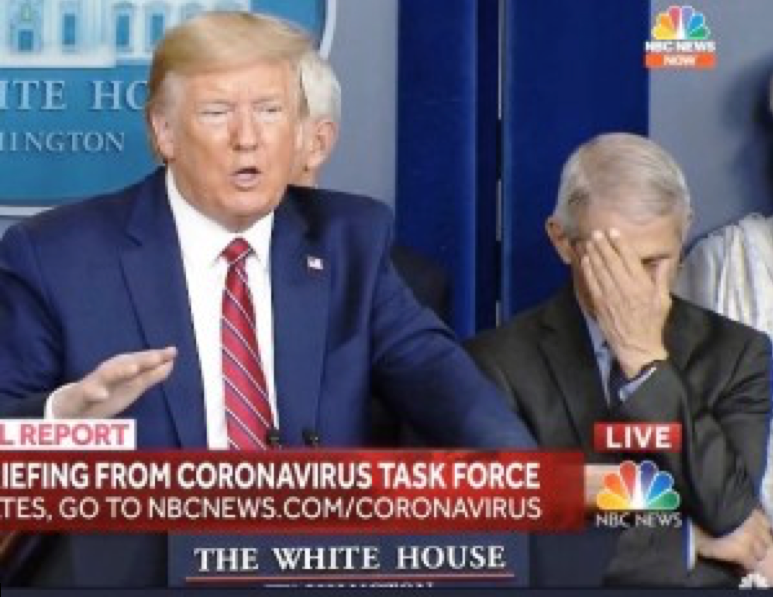CommentsCALBUZZ--Thoughtful people who have witnessed President Trump’s ignorant, incompetent, idiotic news conferences on the Coronavirus find themselves ready to slit their wrists when they see that the president’s approval rating has gone up to 49% in the latest Gallup Poll.
Fear not. As Abraham Lincoln is professed to have said: You can fool all the people some of the time and some of the people all the time, but you cannot fool all the people all the time.
What we’re seeing is known in the polling and political science business as the rally effect – “the sudden and substantial increase in public approval of the president that occurs in response to certain kinds of dramatic international events involving the United States.”
It fades away.
Pretending to be president “Historically, presidential job approval has increased when the nation is under threat,” according to Gallup senior editor Jeffrey M. Jones.
“Every president from Franklin Roosevelt through George W. Bush saw their approval rating surge at least 10 points after a significant national event of this kind. [George W.] Bush’s 35-point increase after 9/11 is the most notable rally effect on record. During these rallies, independents and supporters of the opposing party to the president typically show heightened support for the commander in chief.”
Here’s some context, from a wide-ranging investigation of Wikipedia:
– Cuban Missile Crisis: According to Gallup polls, President John F. Kennedy‘s approval rating in early October 1962 was at 61%. By November, after the crisis had passed, Kennedy’s approval rose to 74%. The spike in approval peaked in December 1962 at 76%. Kennedy’s approval rating slowly decreased again until it reached the pre-crisis level of 61% in June 1963.
– Iran hostage crisis: According to Gallup polls, President Jimmy Carter quickly gained 26 percentage points, jumping from 32 to 58% approval following the initial seizure of the U.S. embassy in Tehran in November 1979. However, Carter’s handling of the crisis caused popular support to decrease, and by November 1980 Carter had returned to his pre-crisis approval rating.
– Operation Desert Storm (Persian Gulf War): According to Gallup polls, President George H. W. Bush was rated at 59% approval in January 1991, but following the success of Operation Desert Storm, Bush enjoyed a peak 89% approval rating in February 1991. From there, Bush’s approval rating slowly decreased, reaching the pre-crisis level of 61% in October 1991.
– Following the September 11 attacks in 2001, President George W. Bush received an unprecedented increase in his approval rating. On September 10, Bush had a Gallup Poll rating of 51%. By September 15, his approval rate had increased by 34 percentage points to 85%. Just a week later, Bush was at 90%, the highest presidential approval rating ever. Over a year after the attacks occurred, Bush still received higher approval than he did before 9/11 (68% in November 2002). Both the size and duration of Bush’s popularity after 9/11 are believed to be the largest of any post-crisis boost. Many people believe that this popularity gave Bush a mandate and eventually the political leverage to begin the War in Iraq.
– Death of Osama bin Laden: According to Gallup polls, President Barack Obama received a 6% bump in his Presidential approving ratings, jumping from 46% in the three days before the mission (April 29 – May 1) to a 52% in the 3 days after the mission (May 2–4). The rally effect didn’t last long, as Obama’s approval ratings were back down to 46% by June 30.
Disapproval of Trump is so infused in American public opinion that what he’s getting right now is a bump, not a spike in his approval rating. Even that has been artificially created by his news briefings, at which he pretends to be in command.
As Philip Rucker of the Washington Post explained, “Trump, who campaigned for the presidency by casting himself as a great dealmaker and who prides himself on being the ultimate decider, has sought to leave the impression through his daily public appearances of being in total control of America’s response to the pandemic.
For a deeper dive into the whole rally effect, check out Democratic pollster Stanley Greenberg’s piece in the Atlantic.
And by the way, while Gallup had Trump at 49% approve and 45% disapprove, both Politico and Reuters had it 45% approve and 52% disapprove, The Hill had it 50-50 and YouGov had it 47-51 — so Trump’s bump is more molehill than mountain.
Whether Trump’s almost-certain Democratic challenger, former Vice President Joe Biden, can use Trump’s moral, executive and political incoherence to demonstrate that he represents hope for a better White House remains to be seen. As does Biden, most days.
How’s this for an election slogan: He Couldn’t Do Worse.
(Jerry Roberts is a California journalist who writes, blogs and hosts a TV talk show about politics, policy and media. Phil Trounstine is the former political editor of the San Jose Mercury News, former communications director for California Gov. Gray Davis and was the founder and director of the Survey and Policy Research Institute at San Jose State University. This piece appeared originally in CalBuzz.)
-CW















